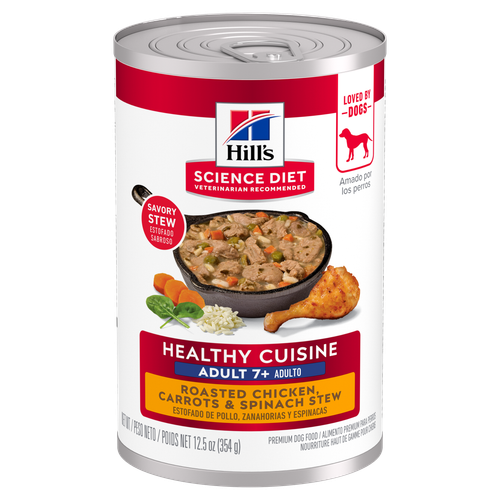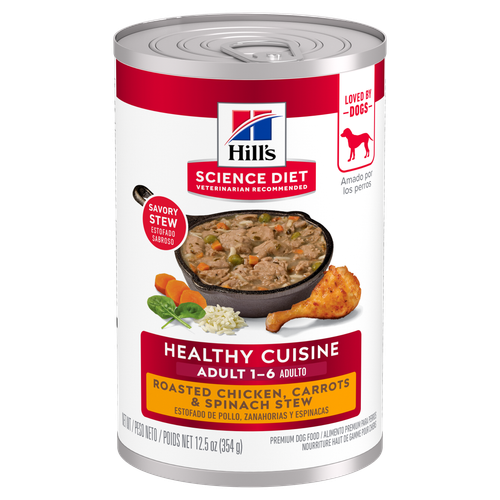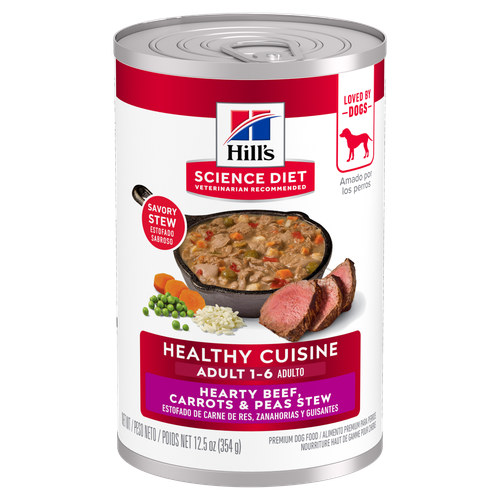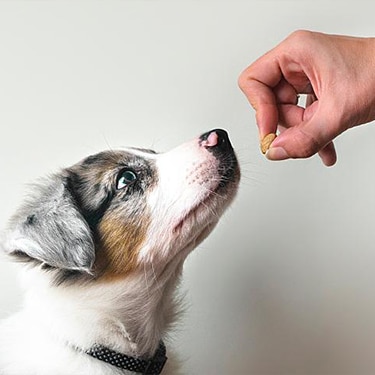
-
Find the right food for your petTake this quiz to see which food may be the best for your furry friend.Find the right food for your petTake this quiz to see which food may be the best for your furry friend.Featured products
 Adult 7+ Healthy Cuisine Roasted Chicken, Carrots & Spinach Stew Dog Food
Adult 7+ Healthy Cuisine Roasted Chicken, Carrots & Spinach Stew Dog FoodDelicious roasted chicken paired with tender vegetables in a succulent stew
Shop Now Adult Healthy Cuisine Roasted Chicken, Carrots & Spinach Stew Dog Food
Adult Healthy Cuisine Roasted Chicken, Carrots & Spinach Stew Dog FoodDelicious roasted chicken paired with tender vegetables in a succulent stew
Shop Now Adult Healthy Cuisine Hearty Beef, Carrots & Peas Stew Dog Food
Adult Healthy Cuisine Hearty Beef, Carrots & Peas Stew Dog FoodHearty beef paired with tender vegetables in a savory stew
Shop NowFeatured products Adult 7+ Indoor Chicken Recipe Cat Food
Adult 7+ Indoor Chicken Recipe Cat FoodSupports energy level and beautiful fur in mature indoor cats
Shop Now Senior Vitality Adult 7+ Tuna & Vegetables Stew
Senior Vitality Adult 7+ Tuna & Vegetables StewImproves Everyday Ability to Get Up & Go
Shop Now Adult Turkey & Liver Entrée Cat Food
Adult Turkey & Liver Entrée Cat FoodPrecisely balanced nutrition with the delicious taste of minced turkey & liver to help fuel the energy needs of cats during the prime of their life
Shop Now -
Dog
- Dog Tips & Articles
-
Health Category
- Weight
- Food & Environmental Sensitivities
- Urinary
- Digestive
- Joint
- Kidney
-
Life Stage
- Puppy Nutrition
- Adult Nutrition
- Senior Nutrition
Cat- Cat Tips & Articles
-
Health Category
- Weight
- Skin & Food Sensitivities
- Urinary
- Digestive
- Kidney
-
Life Stage
- Kitten Nutrition
- Adult Nutrition
Featured articles What Is Littermate Syndrome? Pet Adoption Guide
What Is Littermate Syndrome? Pet Adoption GuideLearn more about littermate syndrome in dogs and cats and how to successfully navigate adoption and early socialization processes.
Read More The Science Behind Our Love for Pets
The Science Behind Our Love for PetsLearn the scientific reasons why we have such strong connections with our pets, and what science says about the love between humans and our furry friends.
Read More How to Properly Mix Wet & Dry Pet Foods
How to Properly Mix Wet & Dry Pet FoodsAn Orange cat eating from a bowl filled with mixed food
Read More -


Your dog depends on you for his happiness and comfort, and you want the best care possible for him. If you have to be away from home for an extended period of time and can’t take him with you, it’s important for you to find a place that will look after him and care for his needs. Consider these options before making your decision, so you can enjoy your vacation knowing he is in the best possible hands.
Know Your Dog’s Needs First
Before deciding which dog sitting option is the best for your canine friend, it is important to consider your dog’s behaviors and needs. Here are some questions you should ask yourself:
- Does your dog have any health or nutritional issues that need to be properly addressed? Medicines, prescription foods or physical restraints, perhaps?
- Have you left him alone for long periods in the past, or do you spend most of your time at home with him?
- Is he primarily an indoor or outdoor dog?
- Does your dog roam free at home when you’re gone, or do you kennel him each time you leave?
- Does he get along well with other people, dogs, or pets? Does he favor men or women, children or adults?
- Is there a chance that your absence could be extended unexpectedly, for which he would need additional care?
- Does your dog have unusual or bad habits that your dog sitter should be made aware of beforehand, such as digging holes in the yard, going to the bathroom in the house, or hiding when nervous?
Once you’ve answered all of these questions, you should have a better sense of what your dog needs from a dog sitter, allowing you to choose the best possible care for him while you’re away.
Kenneling Dogs
 A reputable dog boarding kennel will provide your pup with reliable care and attention, along with being able to monitor him for health problems. Dog boarding can be a pricey option because it is a professional service, but the benefits can outweigh the costs. Professional boarding kennels are well-equipped to handle the needs of dogs, and it can give you peace of mind to know your dog will be well cared for.
A reputable dog boarding kennel will provide your pup with reliable care and attention, along with being able to monitor him for health problems. Dog boarding can be a pricey option because it is a professional service, but the benefits can outweigh the costs. Professional boarding kennels are well-equipped to handle the needs of dogs, and it can give you peace of mind to know your dog will be well cared for.
Ask your veterinarian or local animal shelter for recommendations on the best kennels in your area. Before you make a final decision, do your research, read reviews of the kennel online, ask friends about kennels they’ve used, and always go for a visit before dropping your dog off.
There are several things to look for when choosing the right kennel for your dog:
- State inspection license: If your state requires boarding kennel inspections, the kennel should have the certificate displayed.
- Current vaccinations: There’s nothing worse than having to worry about your pup being sick when you’re gone, so be sure the kennel requires all pets to be up-to-date on their vaccinations.
- Take a tour of the facility. It should be clean and organized, especially in the areas where your dog will be sleeping and hanging out during the day. The temperature should be comfortable, and there should be sufficient light and ventilation.
- Outdoor areas should be secure and protected from the elements.
- Space: Each dog has individual, adequately sized kennel space and bedding is provided.
- Scheduled exercise time: If the kennel allows for playgroups, these should be supervised by trained staff members.
- Staff is knowledgeable and friendly.
- You or your kennel should have current pet insurance in case your dog requires emergency care while you’re away.
You may also consider veterinary care, bathing, grooming, or training for your dog. Ask the kennel if they provide any of these services. Discuss his special needs, medical conditions, or behavioral issues with the staff.
Some dogs are the wrong fit for boarding at kennels. If your dog doesn’t do well around other dogs or has problems with aggression or separation anxiety, he might not do well at a kennel. Consider doing an overnight or weekend trial run first to get him accustomed to his new environment and make sure he doesn’t have any problems while there. Before you leave, give the staff your and your vet’s contact information, along with your dog’s medications, favorite toys, and enough food to last him the duration of his stay. Suddenly switching to a different food can trigger severe stomach upset.
In addition to traditional kennels, there are more luxurious options like pet spas and doggy day cares, which provide anything from massages to pools to “pawdicures” for your dog.


Tasty Tips
Dog Sitting at Your Home
It is great to have friends, neighbors and relatives that you can rely on for all sorts of favors, and dog sitting is no exception. One of the easiest ways to alleviate any concerns about leaving your dog is to let someone you trust stay at your home and both house sit and dog sit. This will allow your dog to be more comfortable in his natural environment.
It is also very important to be detailed in your instructions with your caretaker. This will help them provide the same great care for your dog that you would. Start by inviting the caregiver over to interact with your dog, so they can get acquainted and he will recognize the dog sitter when they come to stay. Ask them to feed, walk, and play with him. This can help ease any anxiety felt by either of them.
Next, be sure to leave your dog sitter with a full checklist of your dog’s needs and daily routines with step-by-step instructions. This includes showing them where the dog food is and how much to provide each day, where you keep his favorite toys, and any games he likes to play. You should also include a phone number and address for your veterinarian, and emergency vet services in case your dog becomes ill or injured.
It’s also important to be honest with your dog sitter. If you’re not comfortable with them having guests over because your dog has trouble with new people, let them know. If he likes to snuggle when you sleep, make sure they are aware, so they aren’t shocked to find a dog sleeping on their chest in the morning. If he is not allowed on the furniture or doesn’t get along well with the neighbor’s dog, they should know ahead of time.
Finally, give them a contact number and the place you are staying in case they have any questions or concerns that don’t come up while you’re gone. It is critical to choose someone you trust, so that they are comfortable and empowered to make a decision if they cannot reach you.
Dog Sitting at the Caretaker’s Home
You also have the option of asking a friend or relative to let your dog stay over at their house. This puts less pressure on your friends and relatives because they will be able to sleep in their own beds and keep their own routines. This can be a great option for both your caretaker and your dog, especially if they have already met and are familiar with one another.
Remember to be considerate when choosing this option because not all dogs are comfortable away from home when you’re not there and might act out. This could make for an awkward situation with your caretaker when you come home. Consider taking your pup to the caretaker’s home well before your trip to get used to the people and surroundings in the new house and reduce his anxiety at the time of the trip. It is also important to do a meet-and-greet with the caretaker’s pets, if they have dogs, cats or other animals already living in their home.
Be sure to make a checklist of things to send with your dog to the dog sitter’s home prior to your trip. This could include basics like their bed, food bowl and dog food, but also include a favorite toy or a comfort item like one of your worn t-shirts. And just like having a caretaker stay at your home, make sure they have detailed instructions on providing care for your dog, including any and all emergency contact information.
Asking Someone to Check In On Your Dog Periodically
Asking a reliable person to stop by your house a few times a day to feed, potty, and play with your dog seems like an easy option. This can often be the cheapest of routes, but often does not provide as high of care as he is used to receiving.
Having a caretaker stop in occasionally isn’t always convenient for them, so your dog’s schedule might get interrupted. This becomes problematic for dogs that are used to routines like eating or going outside at the same time everyday. And if he is used to someone being around when he sleeps at night, it could also upset his sleep routine.
If your dog is not used to being home alone, he could develop anxiety or depression and seem distant when you return home after your trip. He might also act out and tear the house up as punishment for leaving him home alone. If you are concerned about bad behavior as a result of separation anxiety, please consider one of the other house sitting options.
If you decide to rely on someone to come to your home periodically and take care of your dog, make sure it is someone you can really trust and count on to follow through. Choose someone that can devote a good amount of their time to stay and play with him, so he remains happy and active. Typically it is most helpful to choose someone that lives within a very short distance of your home so that they can quickly check in on your dog under certain circumstances such as bad weather.
Finally, like other at-home options, it is always a good idea to invite them over ahead of time to meet and play with the dog, so your pup can get used to the new face coming around everyday. Ask your friend or relative to feed and walk your dog a few times before you leave, to make sure that the two are getting along and there aren’t any issues you didn’t consider or questions your dog sitter needs answered. Also, don’t forget to leave them with detailed instructions and emergency contacts just in case.
Ready to Choose a Dog Sitting Option?
Now that you know your dog-sitting options while on vacation, be sure to do your research and vet each choice to find the one best suited to your dog. Every dog has a unique personality with unique needs. Make every effort to find the best dog sitter possible for your dog, and both you and and your dog can have peace of mind while you’re on vacation.
Related products

Chicken & Beef Entrée in a delicious loaf with complete & balanced nutrition to help keep adult dogs active and healthy

Chicken & Barley Entrée in a delicious loaf with great taste and precisely balanced nutrition to support 5 essential building blocks for lifelong health

Supports healthy joints, lean muscle, and beautiful coat for large breed dogs

Supports lean muscle and beautiful coat for adult dogs
Related articles

Wondering where can I buy a dog? Consider adoption and explore the pros and cons of adopting a dog from a breeder versus an animal shelter.

Discover how the field of dog science is giving us more and more insights into the inner workings of our furry best friends.

Can puppies have treats? Explore best practices for giving your puppy treats to ensure you're doing so in the healthiest way possible.

Learn how to help keep your dog's immune system in tip-top shape, including nutritional immune system support for dogs and other strategies.

Put your dog on a diet without them knowing
Our low calorie formula helps you control your dog's weight. It's packed with high-quality protein for building lean muscles, and made with purposeful ingredients for a flavorful, nutritious meal. Clinically proven antioxidants, Vitamin C+E, help promote a healthy immune system.
Put your dog on a diet without them knowing
Our low calorie formula helps you control your dog's weight. It's packed with high-quality protein for building lean muscles, and made with purposeful ingredients for a flavorful, nutritious meal. Clinically proven antioxidants, Vitamin C+E, help promote a healthy immune system.


